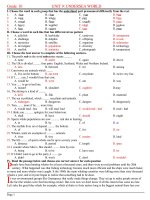Unit 9. Undersea world
Bạn đang xem bản rút gọn của tài liệu. Xem và tải ngay bản đầy đủ của tài liệu tại đây (3.54 MB, 19 trang )
CROSSWORD GAME
?
1
?
2
?
3
T U
?
4
A
?
5
D U G O
P
N
A C
R T
T
A
L
L
I
F
I
C
E
A
N
G
N
T
A
T
I
R
C
C
T
I
1. What animanl is it?
2. What is the biggest Ocean in the world?
3. Which animal is it?
4. On which Ocean was the Titanic sunk?
5.This is the place where the penguins can live
C
I.Pre-reading:
There is only one ocean. It’s divided into five different
parts: the
Pacific, Atlantic,Indian, Antartic, and Arctic Ocean. There are
also many other smaller seas, gulf and bays which form part
of them. Altogether they cover 75 percent of the earth’s
surface. For centuries, people have challenged by the
mysteries that lie beneath the ocean. However, today’s
scientists have overcome many of the challenges ofthe depth
by using modern devices. They send submarines to
investigate the seabed and bring samples of marine life back
to the surface for further study. Satellite photographs
provide a wide range of information, including water
temperature, depth and the undersea populations. If modern
technology did not exit, we would never have such precious
information.
Marine plants and animals fall into three major groups.
Some of them live on or depend on the bottom like the
starfish. Some are swimming animals such as fishes and
sharks that move independently of water currents while
GAME: CATCHING WORDS
- Work in groups, guess the words
hidden from the given pictures and
information.
- With a correct answer, your group
will get 10 marks.
This is a large area of sea that is partly
surrounded by land
*gulf (n): vịnh
Things
that
scientists bring back
from the seabed for
further study.
sample (n)
This is a modern device which the scientists
use to investigate the seabed.
-> submarine
(n)
Oversized(
a)
Tiny
(a)
->investigate (v)
-> challenge (n/v)
At stake = at risk
Biodiversity(n)
Water current (n)
I. Vocabulary:
gulf (n) / gʌlf / :
vịnh biển
sample (n) ['sɑ:mpl] :
mẫu vật
oversized (a) ['ouvəsaiz] : to quá khổ
tiny (a) ['taini] :
nhỏ xíu
investigate (v) [in'vestigeit]:
điều tra , nghiên
cứu
challenge (n/v): ['t∫ælindʒ] thử thách
biodiversity (n) :
đa dạng sinh học
submarine (n) [,sʌbmə'ri:n] :
tàu ngầm
water current(n) : dòng nước
at stake = at risk : bị đe dọa
II.While you read
Task 1: fill each blank with one of the word given:
gulf
investigate
oversized
tiny
biodiversity
samples
challenges
provide
tiny
1. Some plants and animals are referred
to as
……...organisms because they are extremely small
2. Thank to modern technology, scientists have
investigate
been
able to …………………the life of plants and
animals that live under the sea.
gulf
3. A…………..is
a large area of the sea that is partly
surrounded by land
4. biodiversity
……………….is a term that refers to the existence
of different kinds of animals and plants which
make a balanced environment
samples
5. These scientists have collected different
………………..to analyse for their experiment.
Task 2 : answer the questions
1. What percentage of the earth’s surface is
covered by seas and oceans?
2. How do scientists now
challenges of the depth?
overcome
the
3. What can submarines do to help scientists
know about the undersea world?
4. What can we learn from the satellite photos?
5. What are the three groups of marine plants
and animals?
6. What would happen if the sea biodiversity
were not maitained?
III. POST READING
three-quarters of the
Though covering ………...........
earth’s surface, the ocean has
mysterious
remained …………….
to us until recently.
modern technology
With …………
discoveries
we have now made important …………
about the biodiversity
…………. of marine life. We have
huge all
learnt that whether tiny or ……,
plants and animals of the sea are
the …………................
closely
connected
…………
……….









